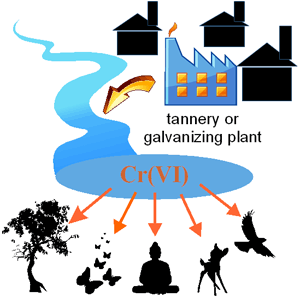The development of biotechnology for water purification from toxic hexavalent chromium by duckweed plants (Lemna minor L.)
From ICBGE
(Difference between revisions)
m |
|||
| Line 1: | Line 1: | ||
| − | [[Image:Problem of environmental pollution Cr(VI).gif|left | + | [[Image:Problem of environmental pollution Cr(VI).gif|left]] |
As chromium compounds were used in dyes and paints and the tanning of leather, these compounds are often found in soil and groundwater at abandoned industrial sites, now needing environmental cleanup and remediation per the treatment of brownfield land. Primer paint containing hexavalent chromium is still widely used for aerospace and automobile refinishing applications. | As chromium compounds were used in dyes and paints and the tanning of leather, these compounds are often found in soil and groundwater at abandoned industrial sites, now needing environmental cleanup and remediation per the treatment of brownfield land. Primer paint containing hexavalent chromium is still widely used for aerospace and automobile refinishing applications. | ||
World Health Organization recommended maximum allowable concentration in drinking water for Cr (VI) is 0.05 mg/l. | World Health Organization recommended maximum allowable concentration in drinking water for Cr (VI) is 0.05 mg/l. | ||
Revision as of 13:17, 6 March 2015
As chromium compounds were used in dyes and paints and the tanning of leather, these compounds are often found in soil and groundwater at abandoned industrial sites, now needing environmental cleanup and remediation per the treatment of brownfield land. Primer paint containing hexavalent chromium is still widely used for aerospace and automobile refinishing applications.
World Health Organization recommended maximum allowable concentration in drinking water for Cr (VI) is 0.05 mg/l.
